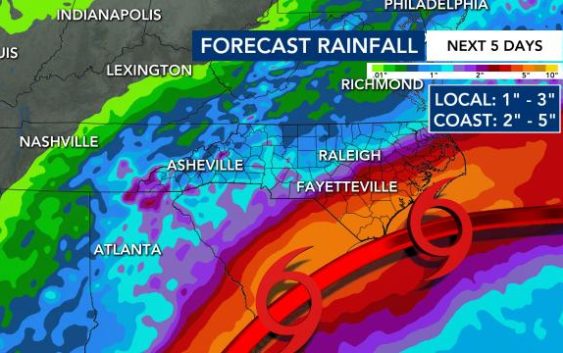- Houston Emergency Operations Center remains on high alert after multiple rounds of severe weather
- ‘A sense of renewal’: Caddo Mounds historic site reopens 5 years after tornado destroyed property
- Check the latest list of closed streets in downtown Houston from storm damage earlier this month
- The night that one-fifth of the population of a Texas town died in a tornado
- SAWS water main break floods I-35 in San Antonio
Idalia strengthens to a hurricane, pushing a surge of ocean water toward Florida

Much of Florida was in disaster mode on Tuesday with only hours to go before an onslaught from Idalia, forecast to strengthen rapidly into “an extremely dangerous major hurricane” before hitting the Gulf Coast on Wednesday.
Florida residents loaded up on sandbags and evacuated from homes in low-lying areas along the Gulf Coast to prepare for a storm that the National Hurricane Center projected could have sustained winds of up to 120 mph (193 kph). That would make it a Category 3 hurricane — a potentially big blow to a state still dealing with lingering damage from last year’s Hurricane Ian.
Hurricane Idalia to track through Florida, Georgia, SC, NC
At 8 a.m. EDT Tuesday, Hurricane Idalia was about 320 miles (515 kilometers) south-southwest of Tampa, with maximum sustained winds of 80 mph (130 kph), the hurricane center said. Idalia was moving north at 14 mph (22 kph).
The center of Idalia will most likely hit a lightly populated area of the Gulf Coast known as the Big Bend before crossing the peninsula and drenching southern Georgia along with the Carolinas on Thursday, forecasters said.
Idalia was expected to make landfall along Florida’s west coast on Wednesday morning between 9 and 11 a.m., with a storm surge of up to 12 feet possible north of Tampa.
The storm track then brings it northeast on Thursday through Georgia and South Carolina and off southeast coast of North Carolina.
North Carolina could see rain begin Thursday in the afternoon.
WRAL meteorologist Elizabeth Gardner said, “Expect an inch rain in our northern counties, 2 to 4 inches in the Triangle, 4 to 6 inches southeast of the Triangle and up to 8 inches at the coast.”
Coastal North Carolina will see the biggest impact from Idalia. The greatest threat is for flooding, especially flash flooding through Friday morning.
Florida residents hunker down ahead of Idalia
“You still have time this morning to make your final preparations … but you gotta do that now.” Gov. Ron DeSantis announced at the state’s emergency operations center. Tolls have been waived on highways out of the danger area, shelters have opened, hotels are prepared to take evacuees and more than 30,000 utility workers are being staged to make repairs as quickly as possible in the hurricane’s wake, he said.“You do not have to leave the state. You don’t have to drive hundreds of miles. You have to get to higher ground in a safe structure. You can ride the storm out there, then go back to your home,” DeSantis said.
“Right now, the biggest hazards are storm surge,” Robbie Berg, a senior hurricane specialist at the National Hurricane Center in Miami, said Tuesday morning. “We’re expecting a surge as much as 8 to 12 feet above normal tide levels in portions of the Big Bend area of Florida.”
Idalia thrashed Cuba with heavy rain, especially in the westernmost part of the island, where the tobacco-producing province of Pinar del Rio is still recovering from the devastation caused by Hurricane Ian. Residents were evacuated to friends’ and relatives’ homes as up to 4 inches (10 centimeters) of rain fell, meteorological stations reported.
Idalia is the first storm to hit Florida this hurricane season, but only the latest in a summer of natural disasters, including wildfires in Hawaii, Canada and Greece; the first tropical storm to hit California in 84 years, and devastating flooding in Vermont.
Florida airports close; expect delays along east coast
Tampa International Airport and St. Pete-Clearwater International Airport said they would close on Tuesday, and the Sunrail commuter rail service in Orlando was being suspended.
Many school districts along the Gulf Coast said they would be closed Tuesday and Wednesday. Several colleges and universities said they would close their campuses on Tuesday, including the University of Florida in Gainesville.
“They told us that our dorm building, especially, is prone to flooding,” said Erin Amiss, a student at Eckerd College in St. Petersburg.
MacDill Air Force Base, located on Tampa Bay, is preparing to evacuate several aircraft and began a mandatory evacuation Monday morning for personnel who live in local counties, the Air Force said in a statement.
The National Oceanic and Atmospheric Administration recently said the 2023 hurricane season would be far busier than initially forecast, partly because of extremely warm ocean temperatures. The season runs through Nov. 30, with August and September typically the peak.
___
Associated Press contributed to this report.

